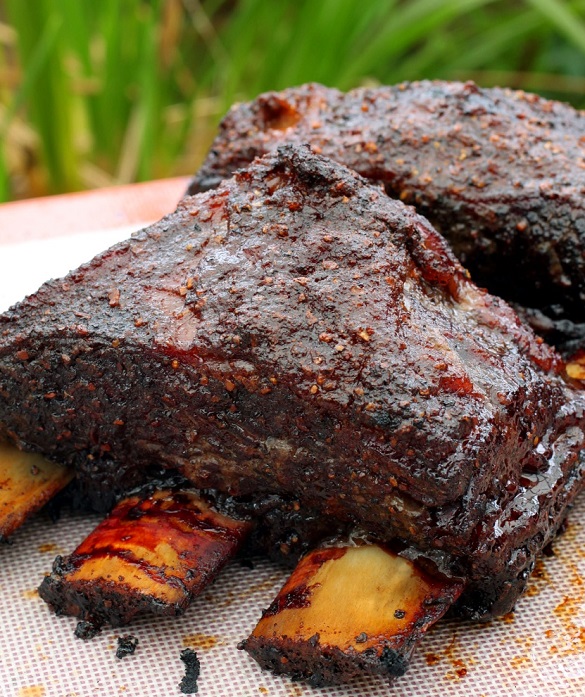Ingredients
- 3-bone piece of Choice-grade Beef Short Rib (about 3 1/2 lbs)
- 2 tablespoons Best Foods Mayo
- 4 tablespoons SYD Hot Rub
- 1 cup dark brown sugar
- 1 can Kearn’s Mango Nectar
- 1/2 cup Grandma’s Original Molasses All Natural
- Cayenne pepper
- 1/2 cup of your favorite barbecue sauce
Instructions
- Trim excess fat cap from the beef short rib.
- Rub all the surfaces with Best Foods Mayo. This will help ensure a tacky surface for the rub to stick and it also helps to tenderize the meat
- Apply enough SYD Hot Rub on all exposed surfaces until you cannot see the meat underneath (about a medium-heavy coat)
- Let sit uncovered in refrigerator for about ½ hour.
- Heat up your smoker to 275 degrees. Once it gets to temp, add three tennis-sized chunks of hickory wood and three tennis-sized chunks of apple wood
- Smoke the short ribs until the crust or bark is formed, about 2-3 hours. Once the crust starts to form (about 90 minutes), spray the ribs with plain tap water from a spray bottle. Repeat the spraying every 15 minutes.
- Once the crust has set, remove ribs from smoker and place in the middle of a sheet of aluminum foil
- Sprinkle dark brown sugar evenly on the ribs. Drizzle some Kearn’s Mango nectar (about 2 tablespoons) over the ribs. Turn ribs over and repeat the brown sugar and Kearn’s on the other side
- Wrap the ribs tightly in foil and return to the pit.
- Check for tenderness using a bamboo skewer after 45 minutes by opening the foil. The skewer will go through like a muffin when it is done. If not yet tender, close the foil and check in 15 minutes. Keep checking until the meat is probe tender
- Remove when done and open the foil to vent (this step is very important else the ribs will overcook).
- Once ribs have cooled a bit, remove from the foil pouch. Mix some molasses with the au jus in the foil and brush the molasses/au jus on the ribs. Then apply a thin coat of your favorite barbecue sauce. Give it a dust of cayenne pepper before you slice and serve. Enjoy!

- Prep Time: 20 mins
- Cook Time: 3 hours
- Category: Entree
- Cuisine: American


